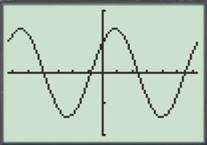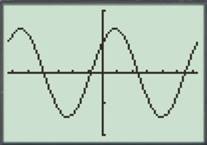
Concept explainers
(a)
To plot:The graph of function
(a)
Explanation of Solution
Given information:The function is
Graph:
To plot the graph of function
Step 1: Press “ON” button to open the calculator. Press
Step 2: Write the right hand side of the function
Step 3: Press

Figure (1)
Interpretation: From the above graph it can be observed that it is a graph of sine or cosine function with shifting and amplitude will be greater than 1.
(b)
To find: The amplitude, period, horizontal shift and vertical from the graph of the function.
(b)
Answer to Problem 56E
For the function
Explanation of Solution
Given information:The function is
Calculation:
From part (a), the graph of the function in the window

The period is the distance required to complete one cycle of a function. From the above graph, it can be observed that one cycle is completed from
The height from the center line to the peak of the graph shows the amplitude of the function. So, the amplitude of the given function is
The upwards or downwards shifting of a graph is known as the vertical shift. From the graph it can be observed that there is no vertical shift of the graph.
The left or right shifting of a graph is known as the horizontal shift. From the graph it can be observed that the graph of the given function is shifted
Therefore, the amplitude is
Chapter 1 Solutions
Calculus 2012 Student Edition (by Finney/Demana/Waits/Kennedy)
Additional Math Textbook Solutions
Precalculus: Concepts Through Functions, A Unit Circle Approach to Trigonometry (4th Edition)
University Calculus: Early Transcendentals (4th Edition)
Precalculus Enhanced with Graphing Utilities (7th Edition)
Calculus and Its Applications (11th Edition)
Single Variable Calculus: Early Transcendentals (2nd Edition) - Standalone book
Calculus & Its Applications (14th Edition)
 Calculus: Early TranscendentalsCalculusISBN:9781285741550Author:James StewartPublisher:Cengage Learning
Calculus: Early TranscendentalsCalculusISBN:9781285741550Author:James StewartPublisher:Cengage Learning Thomas' Calculus (14th Edition)CalculusISBN:9780134438986Author:Joel R. Hass, Christopher E. Heil, Maurice D. WeirPublisher:PEARSON
Thomas' Calculus (14th Edition)CalculusISBN:9780134438986Author:Joel R. Hass, Christopher E. Heil, Maurice D. WeirPublisher:PEARSON Calculus: Early Transcendentals (3rd Edition)CalculusISBN:9780134763644Author:William L. Briggs, Lyle Cochran, Bernard Gillett, Eric SchulzPublisher:PEARSON
Calculus: Early Transcendentals (3rd Edition)CalculusISBN:9780134763644Author:William L. Briggs, Lyle Cochran, Bernard Gillett, Eric SchulzPublisher:PEARSON Calculus: Early TranscendentalsCalculusISBN:9781319050740Author:Jon Rogawski, Colin Adams, Robert FranzosaPublisher:W. H. Freeman
Calculus: Early TranscendentalsCalculusISBN:9781319050740Author:Jon Rogawski, Colin Adams, Robert FranzosaPublisher:W. H. Freeman
 Calculus: Early Transcendental FunctionsCalculusISBN:9781337552516Author:Ron Larson, Bruce H. EdwardsPublisher:Cengage Learning
Calculus: Early Transcendental FunctionsCalculusISBN:9781337552516Author:Ron Larson, Bruce H. EdwardsPublisher:Cengage Learning





